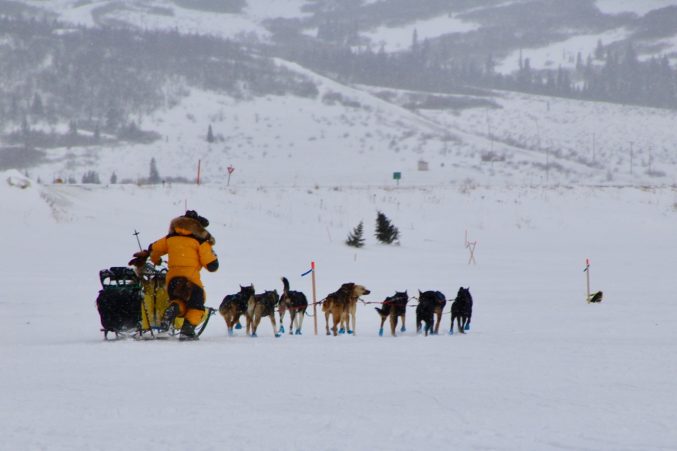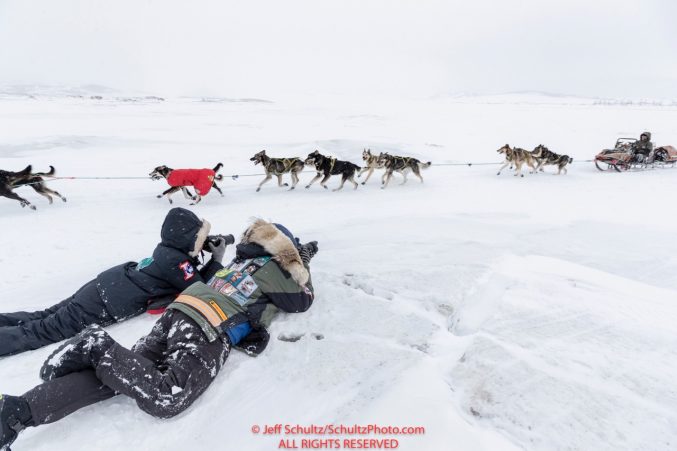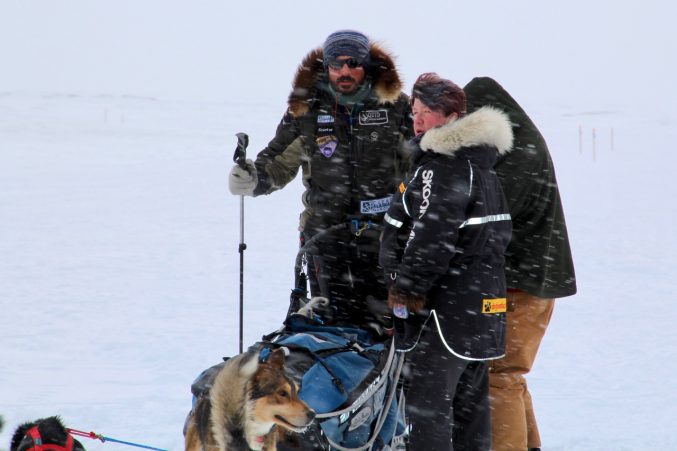For the three leading teams that departed Shaktoolik during the wee hours of the morning, the run to Koyuk has been a challenge. Leading the pack was Nic Petit but Joar Leifseth Ulsom overtook him. Taking a wrong turn on the run to Koyuk, Petit lost the trail. Joar passed him by and arrived in Koyuk at 13:01 after 8 hours and 13 minutes on the Norton Sound trail. Joar didn’t realize that he had arrived in Koyuk first. Petit arrived at 14:10 with a run time of 13 hours. Seavey arrived at 15:55 covering the distance in 12 hours 12 minutes. When interviewed by the Insider Team, Petit said these types of storms have been all along the trail. Inland there are trees and other physical features to block the wind. On the coast, a storm is a storm and there’s nothing to block the wind and blowing snow. Wondering what it’s like to run in a coastal storm? Check the videos Insider has posted. You can feel the punishment the wind and snow is dishing out even while warm and cozy at home in front of your computer.
- Michi Konno Departs for Shaktoolik Facing Wind and Snow
Back a few miles in Unalakleet; it’s a peaceful scene. Michi Konno departed at 13:37 with nine dogs. There are seven teams resting on the slough and seven mushers resting inside the checkpoint. The seven arrived between 12:46 and 1:46. Having all those teams arrive together is normally a photographer’s dream but with the heavy snow, the camera was a little confused as to what to focus on but there’s always manual focus.
Mike Williams who parked at 12:46 is running his seventh Iditarod. His highest finish was 8th in 2012. His best time is 9 days, 11 hours and 50 minutes. Mike Jr. lives in Akiak, AK. He’s been running dogs since being old enough to stand on a sled. He has helped his father Iditarod veteran, Mike Sr. train for Iditarod and other races.
Katherine Keith representing Team Baker from Kotzebue has been resting since 12:52. At the age of 21, Katherine bought an old Ice Cream truck and drove to Alaska to learn how to run a dog team. Since then, Katherine has accomplished six full Ironman Triathlons. Katherine and her fiancé John Baker train more than 70 dogs. She began racing in 2012. This is her fifth Iditarod. Keith completed the Quest in 2017 but had to scratch this year due to injury. From the race guide, “Keith is dedicated to supporting Alaskans in building capacity through responsible, sustainable development in communities large and small.”
- Martin Buser into Unalakleet with Snow and Low Visibility
Four time Iditarod champion, Martin Buser, made the coast at 13:12. Granted it was snowing but the weather was pleasant compared to the weather on Norton Sound. Buser has 32 consecutive Iditarod finishes and 34 total finishes. He has only 261 miles between where he is now in Unalakleet to Nome to make 35 finishes without ever scratching. Martin has received the Leonard Seppala Humanitarian award five times. In 2005, only 4 days before the start of Iditarod Martin amputated part of a finger in a table saw accident. He stubbornly refused to withdraw from the race saying these dogs have worked hard and deserve to prove what they can do. At the conclusion of the race Buser received the Sportsmanship and Most Inspirational Musher Award. From his bio in the race guide, “While the race is always the final exam, the year round interaction and relationship with the dogs is the most valuable aspect of the lifestyle. On a daily basis, we are amazed by the stamina, loyalty, honesty and joy of our dogs.”
- Terrie Hanke (Eye on the Trail) and Heidi Sloan (Teacher on the Trail) take photos of Jeff King as he approaches the Unalakleet checkpoint on Monday afternoon March 12th during the 2018 Iditarod Sled Dog Race
Jeff King, arriving at 13:15, parked across from Martin Buser. That’s a pair that has a lot of Iditarod experience – 61 combined years to be exact. King, a four-time Iditarod Champion, is also the 1981 Yukon Quest Champion. King was born and raised in California and came to Alaska in 1975 seeking adventure. He found the sport of mushing after listening to Jerry Riley’s Iditarod finish in 1976 on the radio. King has run Iditarod 27 times with twenty top-ten finishes and 2 scratches. King has received the Seppala Humanitarian Award for excellent dog care twice.
- Anne Berington in Unalakleet
Anna Berington is into Unalakleet ahead of her usual mushing partner, twin sister Kristi. Anna set her hook on the slough at 13:29 after a 16.5 hour run from Kaltag including a rest at Old Woman safety cabin. Anna was really enjoying the mild temperatures on the run that has many times been twenty, thirty or forty degrees colder. Berington grew up in Wisconsin and started her mushing career with a makeshift sled made of skies and a milk crate pulled by a collie and Great Pyrenees. Anna participates in endurance running. The twins operate Seeing Double Kennel. Anna has the most competitive team from the kennel on the trail this race. Anna ran her first Iditarod in 2012 and is making her way to her 7th Iditarod finish.
Rick Casillo made UNK at 13:43 behind 12 dogs. Casillo began mushing in 2002. As a spectator, Rick became interested in running Iditarod. In 2004 Rick finished in 57th place, two years later he improved to 34th place and received the Most Improved Musher Award. Rick and his wife, Jennifer a combat veteran, have a non-profit organization called Battle Dawgs. The purpose of Battle Dawgs is providing year round camps for warriors all across the country and Alaska. The organization motto is ‘Helping our warriors one step at a time.” The Primary goal of Battle Dawgs Kennel is to raise awareness for combat veterans. Rick has completed seven of his eight Iditarod runs.
- Cody Strathe Checks in with Race Judge Karen Ramstead
Cody Strathe cruised into UNK three minutes behind Rick at 13:46. Cody considers himself an explorer at heart. He came to Alaska as a canoe and backpack guide. He’s been working as a sled builder and archeologist for eleven years. Strathe and his wife, Paige Drobny, own Spearfish Research, a fisheries and archeology consulting company. Through DogPaddle Designs, Cody builds sleds for mushers, canoe paddles and boats. Cody has completed Iditarod twice. He has also completed the Yukon Quest. In 2016 he and Paige ran both the Quest and Iditarod. They are the first couple to run both races in the same winter. Cody and Paige own and operate Squid Acres Kennel.
With snow falling in Unalakleet and mild temperatures this afternoon, it was a sled dog paradise. The dogs rested on straw after enjoying meat snacks and kibble. Most wore coats to conserve body heat and direct calories to energy production. A couple dogs on Anna Berington’s team decided to “undress.” They spun the coats off their backs to their bellies and used them as sleeping pads rather than coats then back to sleep they went.






































